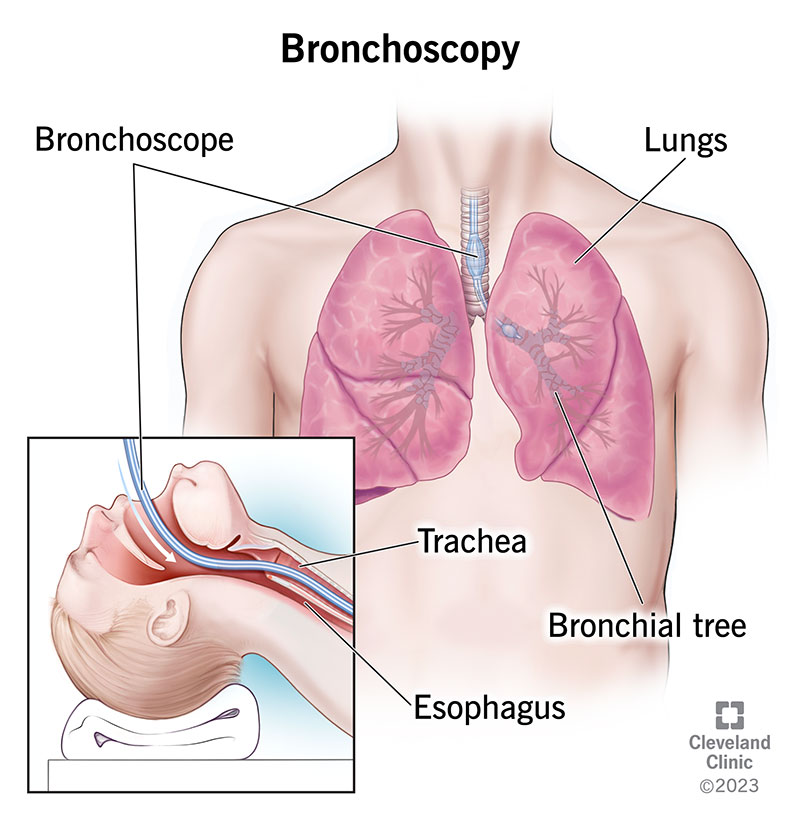Bronchoscopy is a minimally invasive procedure to diagnose problems with your lungs or airways. Healthcare providers use a bronchoscope to look into your windpipe and lungs. They can also put small tools through the bronchoscope to take samples of tissue for testing.
Advertisement
Cleveland Clinic is a non-profit academic medical center. Advertising on our site helps support our mission. We do not endorse non-Cleveland Clinic products or services. Policy

Bronchoscopy is a minimally invasive procedure that lets your healthcare provider look inside your airways and lungs with a bronchoscope. A bronchoscope is a thin tube with a light and camera on it. It can help your provider diagnose, evaluate and sometimes treat conditions that affect your lungs, trachea (windpipe) or throat.
Advertisement
Cleveland Clinic is a non-profit academic medical center. Advertising on our site helps support our mission. We do not endorse non-Cleveland Clinic products or services. Policy
Bronchoscopes can be either rigid or flexible:
A healthcare provider may recommend bronchoscopy to find the cause of lung problems you may be experiencing. Some of the most common are:
Your healthcare providers will give you specific instructions about how to prepare for a bronchoscopy.
But, in general, you’ll need to fast (not eat or drink) for a certain amount of time before the procedure. You may also have to stop taking certain medications like blood thinners or diabetes medication. Be sure to tell your provider about any medications, herbs or vitamins you take.
Advertisement
Your healthcare provider will give you a sedative for the procedure. You should plan on having someone available to drive you home afterward.
Unless you’re in an emergency situation, your healthcare provider will likely order a CT scan before a bronchoscopy. A CT scan of your lungs can help your provider evaluate lung diseases and conditions like cancer or lung damage from smoking cigarettes to help decide if a bronchoscopy is needed.
A pulmonologist typically performs a bronchoscopy in a hospital or surgical center as an outpatient procedure. This means you can go home after the procedure.
You’re typically given some medication to be sleepy and comfortable. Rigid bronchoscopy and many procedures that involve biopsies may require general anesthesia (being asleep). You should discuss which kind of anesthesia your procedure will require with your healthcare provider.
In most cases, a bronchoscopy follows these steps:
Most of the time, you’ll be sleepy, at least, if not asleep. It depends on what type of bronchoscopy you’re having and what your healthcare provider is diagnosing. Many people have the procedure with general anesthesia, and only some procedures can use a local anesthetic (numbing medicine).
You can expect a bronchoscopy to last 30 to 90 minutes. The exact timing depends on why your provider is performing the procedure.
In most cases, bronchoscopy is an outpatient procedure, so you won’t need to spend the night in the hospital. You can typically go home within a few hours of the procedure.
Your healthcare team will monitor you after the procedure to ensure you’re breathing and swallowing properly. Your provider may decide to order a chest X-ray after the procedure to check for any signs of problems.
You may have a numb throat for up to an hour. You may have a sore throat, cough or hoarseness for the next 24 hours. Using cough drops can help with this. Most people can return to normal activities the next day. Your healthcare provider will let you know if you should restrict your activities in any way.
Your healthcare team will let you know when you should expect test results and when you should schedule a follow-up appointment.
Advertisement
You can expect to spend at least 45 minutes recovering, if not longer. Your healthcare team needs to monitor you while the sedation or anesthesia wears off and make sure your vital signs are normal. They also want to make sure you don’t experience any irregular side effects after the procedure.
You shouldn’t eat or drink until the numbness wears off, which could take an hour or more. Once you don’t feel numb, start by sipping water and eating soft foods. Eating and drinking too soon could cause you to breathe the food or drink into your lungs (aspirate) or choke.
Bronchoscopy is a very safe procedure, but there’s a slight risk of:
In most cases, healthcare providers use a flexible bronchoscope, not the rigid bronchoscope. This is because the flexible type is easier to move around your airways and throat. And it provides better access to smaller areas of lung tissue. But some situations require a rigid scope.
Be sure to discuss the risks of a bronchoscopy before surgery. Ask your provider if you’re at a higher risk for complications.
Ask your healthcare team when you can expect results. If they took biopsies during the procedure, the results should be available within one week. Other test results may be available sooner or later depending on the kind of testing.
Advertisement
Your healthcare provider will use the results to determine the next steps of your care. This varies from person to person depending on what your provider finds during the bronchoscopy.
Call your healthcare team if you have any of the following symptoms, which can indicate an infection, collapsed lung or other problem:
Bronchoscopy is a safe procedure that helps your healthcare provider diagnose the cause of lung and airway problems. In some cases, providers also use bronchoscopy to treat lung and airway conditions. This outpatient procedure involves inserting a tube down into your lungs. If your healthcare provider recommends bronchoscopy, you’ll get more details to prepare.
Advertisement
Breathing issues can affect your life in many ways. Cleveland Clinic’s respiratory therapy program treats your symptoms so you can feel better day to day.

Last reviewed on 01/30/2024.
Learn more about the Health Library and our editorial process.